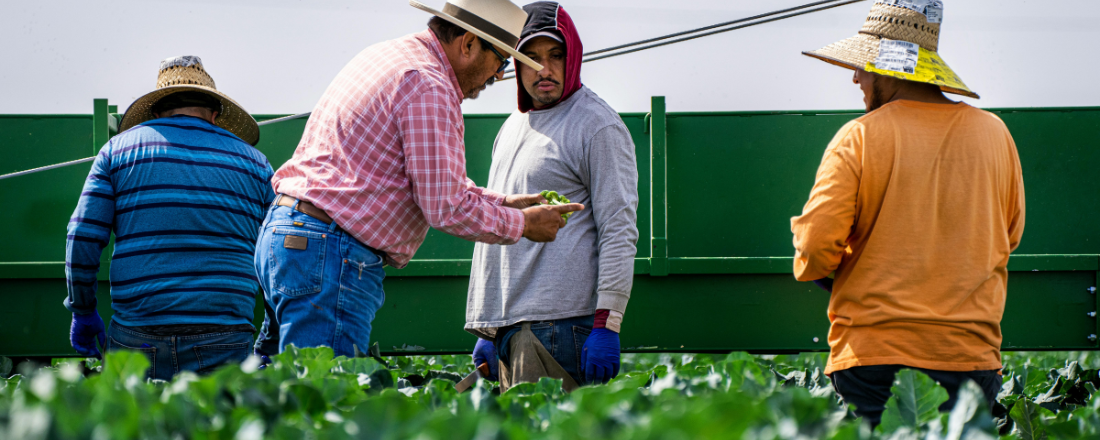
In the News
Farmworkers Feed the Nation and Risk Their Lives: The Deadly Impacts of Extreme Heat and Air Pollution
- Mother Jones
-
Focus Areas
Environmental Health, Healthy Communities -
Issues
Climate Change, Wildfires & Extreme Heat -
Expertise
Outreach & Dissemination, Research – Surveillance, Technical Assistance -
Programs
Tracking California

“For most of July 2019, stifling heat hung over the agricultural fields of California’s Central Valley, as farmworkers like William Salas Jiminez labored under the sun’s searing rays. Temperatures had dipped from 99 to 95 degrees Fahrenheit the last day of the month, when the 56-year-old Puerto Rico native was installing irrigation tubing in an almond orchard near Arvin, at the valley’s southern edge.
Around 1:30 that afternoon, Salas sat down to rest. When he stood up to go back to work, he suddenly collapsed. An hour and a half later, he was dead. Reports filed with the US Department of Occupational Health and Safety, or OSHA, say Salas died of a heart attack.
No federal standard protects workers from extreme heat, though OSHA proposed a rule in 2021—a half-century after public health officials first recommended precautionary measures. California was the first of the five states that have passed a heat exposure standard and its requirements are considered among the toughest. Yet the standard doesn’t recognize an increasingly dangerous threat for agricultural laborers in a warming world: working in hot, polluted air.
According to the 2022 annual report from California OSHA, or Cal/OSHA, just two California farmworkers died from heat exposure between 2018 and 2022.
But an Inside Climate News review of federal farmworker death records, along with temperature and air pollution data, suggests the numbers may be much higher. Scores of farmworkers died in California between 2018 and 2022 when temperatures exceeded the threshold that triggers California’s heat safety requirements. All of these deaths occurred in counties with chronically unsafe air.
Eighty-three of the 168 farmworkers who died suddenly at work in California from 2018 to 2022 perished when temperatures exceeded 80 degrees Fahrenheit—when employers must provide adequate fresh water, shade, and rest to cool down—within a day of their death. Thirty-six of these 83 workers died of heart attacks, strokes, or other cardiovascular diseases; unspecified underlying medical conditions; or unknown or “natural causes.” Twelve died of respiratory conditions, including COVID-19, and one died of methamphetamine toxicity. The other 34 died from injuries sustained in accidents. Heat stress is known to increase the risk of death from cardiovascular and respiratory conditions, including COVID-19, drug use, and workplace accidents.
In three of these cases, air quality for hazardous tiny particles called PM2.5 within a day of a worker’s death was also “unhealthy for sensitive groups,” when people with underlying heart or lung conditions should minimize long or intense outdoor activities. But even if the air quality was normal on the days workers died in the heat, every county they worked in received a failing grade for short-term particle pollution in the American Lung Association’s State of the Air report.
Scientists are gaining new insights into the complex constellation of factors that interact with heat to cause illness and death. They know workers can die of heat stroke even when temperatures fall below the low 80s. They know existing reporting measures vastly underestimate heat-related injuries and deaths. And they’ve discovered that simultaneous short-term exposure to heat and fine particle pollution, both deadly on their own, may be particularly lethal.
It would take a rigorous study to determine whether heat or air pollution triggered the deaths Inside Climate News identified, but it is clear that California’s farmworkers are at high risk, said Paul English, an environmental epidemiologist and director of the Public Health Institute’s Tracking California, a project aimed at improving public health.
The scientific literature shows that conditions of high heat stress the heart, English said.

And there’s been more and more research about air pollution and small particle pollution being related to heart attacks and to hospitalizations and emergency room visits for heart attacks.Paul English, PhD, MPH
Director, Tracking California, Public Health Institute
“This story was originally published by Inside Climate News and is reproduced here as part of the Climate Desk collaboration.”
To read the full article, click on the link below.
Originally published by Mother Jones
More Updates
Work With Us
You change the world. We do the rest. Explore fiscal sponsorship at PHI.
Support Us
Together, we can accelerate our response to public health’s most critical issues.
Find Employment
Begin your career at the Public Health Institute.



